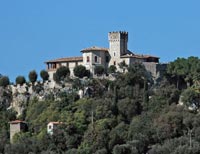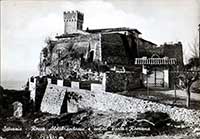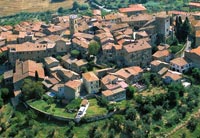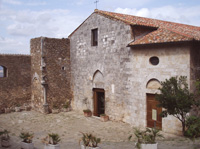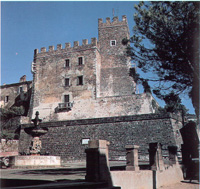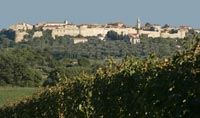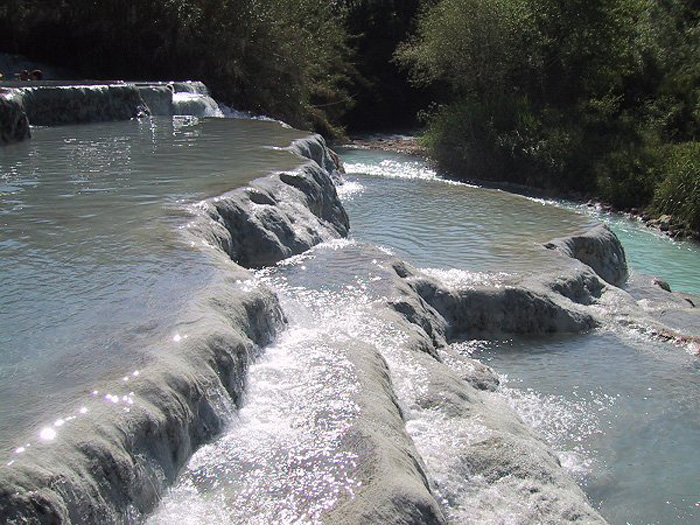 |
|
Saturnia, Cascate del Gorello |
|
|
| Saturnia is a spa town in Tuscany, east of Sovana, that has been inhabited since ancient times. It is a frazione of the comune of Manciano and is famous because of its Spa complex which grew up around the sulphur springs, waterfalls and streams which have drawn those seeking a panacea for their ailments for more than 3000 years. The Etruscans who built the town above are thought to have used these surreal bubbling turquoise waters in sacred rites. Saturnia takes its name from the Roman god Saturn(us). Legend has it that he grew tired of the constant wars of humans, and sent a thunderbolt to earth that created a magic spring of warm sulphurous water which would pacify mankind. The town itself occupies a strategic position, on the summit of a truncated cone, overlooking the Albegna valley. Known as Aurinia, it was one of the most important Etruscan towns. In Roman times its position on the Via Clodio link added to its significance. The Via Clodio passed through a medieval arc known as the Porta Romana, which rests on Etruscan, or even older town walls. It was the Romans who gave this town its name Saturnia. This ancient town with its many natural beauties typifies this mysterious corner of Tuscany which has been said to be 'closer in time and spirit to the ancient Etruria than to the glitter of the Renaissance'. Above an ancient Roman Church there rises the parish church, restored in 1933, and among the ruins of the Sienese keep of Villa Ciacci, erected in the shape of a small medieval castle at the beginning of the 1900s, there is hosted a small Antiquarium that contains local Etruscan and Roman findings. The ancient ruins, however, are few because Saturnia was destroyed by the supporters of Silla in the 1st Century B.C. and then, more than once, by the Saracens. The Spa and waters of Saturnia |
||||
| The waters are sulphurous and have a temperature of 37.5°C. 800 litres of water per second gush out of the hot springs, thus granting constant purity. The therapeutic properties of the waters of Saturnia were already known and used thousands of years ago by the Etruscans and the Romans The spa was built in the 1930’s, but its international renown has increased over the past ten years. Nowadays Terme di Saturnia spa line for skin care is exported also to the US.
|
 Saturnia, Cascate del Gorello |
|||
| The waterfalls of Mulino | Cascate del Gorello |
|
|||
| These spectacular Falls of sulphurous water are produced by the thermal stream known as “Gorello”. Thermal water constantly flows into natural calcareous basins, then into the underlying river Stellata. The springs are divided between two sites: the enchanting natural pools with waterfalls where access is free and you can always bath. Pleasantly light smell of sulphur evaporates from the bluish grey waters. They slowly flow through the reeds and runs to the water basin of the Cascate del Gorello. The entrance is free.
|
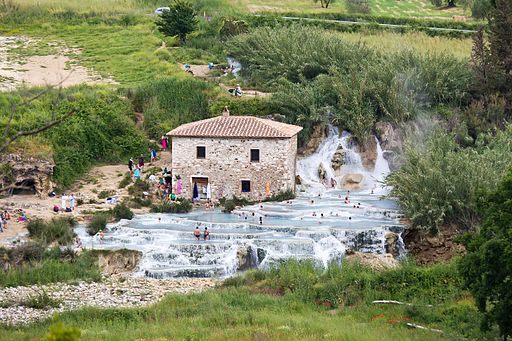 |
|||
|
Photo Gallery Manciano and Saturnia
|
||||
 |
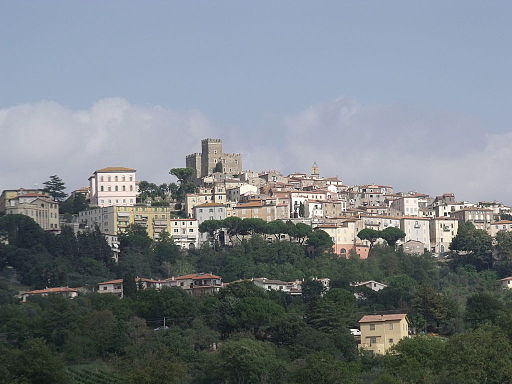 |
 |
||
| Manciano, Saturnia album | Manciano
|
Manciano, Rocca
|
||
 |
 |
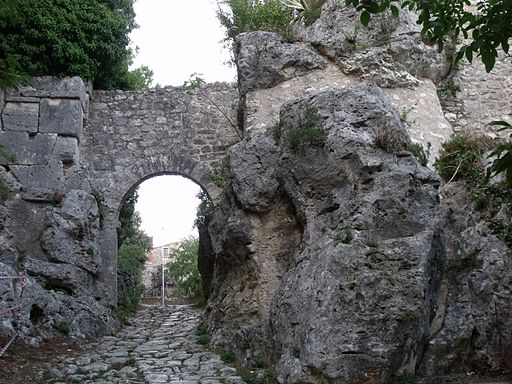 |
||
Saturnia
|
Saturnia, Rocca
|
Saturnia, Mura e Porta Romano | ||
 |
 |
 |
||
| Via Clodia & Porta Romana | Saturnia, Cascate del Gorello
|
Saturnia, Cascate del Gorello
|
||
| Saturnia is also home to many beautiful religious and cultural buildings http://www.poderesantapia.com/album/manciano/including the Church of Santa Maria Magdalena, a sacred building dating back to the Middle Ages and almost completely restored in the first decade of the twentieth century; the Archaeological Museum, which exhibits artifacts found in the nearby necropolis; and the Aldobrandesca Fortress, which dominates the town. The church of Santa Maria Maddalena and the Roman Walls are worth a visit, but he most representative monument is Porta Romana. The Church of Santa Maria Maddalena is the main church in Saturnia. The earliest historical records related to the church date back to 1188, but the building is due to a restoration of 1933. The Chiesa di Santa Maria Maddalena holds the famous Madonna and Child frescoe attributed to Benvenuto di Giovanni at the end of the 15th century. The Porta Romana outside the town was the passage to reach the Baths of Saturnia. The Via Clodio passed through a medieval arc known as the Porta Romana, which rests on Etruscan, or even older town walls. The gate comprises a large round arch built with dry-walled squared stone blocks and the slightly projecting impost blocks are the only architectural feature of note. The Etruscan walls in which the gate stands are made from rough-hewn blocks.
|
||||
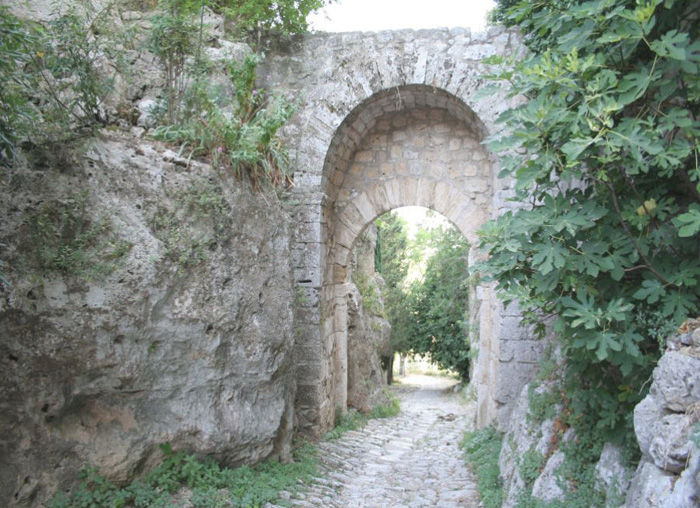 |
|
Saturnia, the Via Clodia and the Porta Romana |
|
|
||||
| Montemerano is a picturesque walled village situated on a beautiful hilltop. Montemerano maintains the look of an ancient medieval castle with it’s antique streets and quaint, charming houses. The 14th century Chiesa di San Giorgio is located in the highest part of the historical centre. It is a splendid example of Romanic architecture and houses one of the most important artistic patrimonies in the province of Grosseto. The church houses an important 15th century polyptych and the Virgin of the Gattaiola, or The Virgin of the Cat Flap. The Virgin was painted by the Master of Montemerano in the 15th century and was originally one of the organ doors. The panel was later used as a barn door by the parish priest who, having some trouble with mice, had a circular hole cut into the lower part of the panel, to let in cats, thus giving the painting the name della gattaiola ('of the catdoor'). The recently restored 15th century frescoes, on the wall to the left, which narrate the stories of St. George and Sant’Orsola, are truly beautiful, as are the frescoes of the Last Judgement and the triumphal arch. But Montemerano’s Church of St. George stands out, above all, because it houses the works of two of the most important 15th century Sienese artists: the sculptures of Vecchietta and an altarpiece by Sano di Pietro. |
|
|||
Manciano is the largest comune of the whole province of Grosseto. In the highest part of the dwelling area there opens the picturesque Piazza Garibaldi were you can admire the monumental fountain of Rosignoli built in 1913 by the occasion of an inauguration of the aqueduct, and the monument of Pietro Aldi, a painter of Manciano. Behind the piazza stands out the majestic Fortress, from which one can enjoy a suggestive panorama from Mount Amiata to the Tyrrhenian Sea.
|
||||
| Magliano in Toscana (and the nearby ruins of the romanesque monastery of San Bruzio). Magliano in Toscana is a n ancient town known in Roman times as Heba. The debate is still open as to its origins which some maintain to be Etruscan and other historians say that it was founded by the Romans. Whatever the truth is it gained importance when around the year 900 the Aldobrandeschi family of Sovana had town walls built which are still in good condition. The churches of San Martino and San Bruzio were built in the same period (1100-1200). About two centuries later, Magliano passed under Sienese rule and in this period the imposing towers were added to the walls. [read more]
|
||||
 |
 |
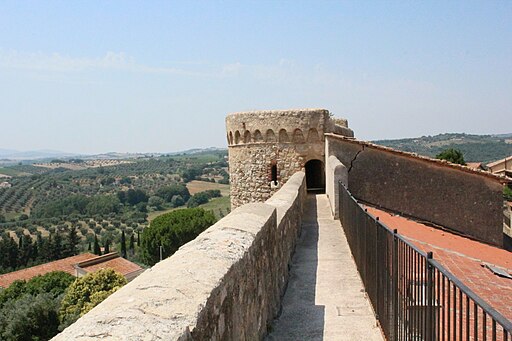 |
||
Particolare del giro delle mura
|
Mura di Magliano in Toscana | Mura di Magliano in Toscana | ||
|
||||
Outdoor-Thermen in southern Tuscany Tuscany is very rich in hot springs. Discover the beautiful outdoor hot springs at Bagni San Filippo, Saturnia and Petriolo in southern Tuscany.
|
||||
 |
 |
 |
||
| Thermal water of Bagni di Petriolo, Monticiano | Bagni San Filippo
|
Bagno Vignoni, Parco dei Mulini | ||
|
||||
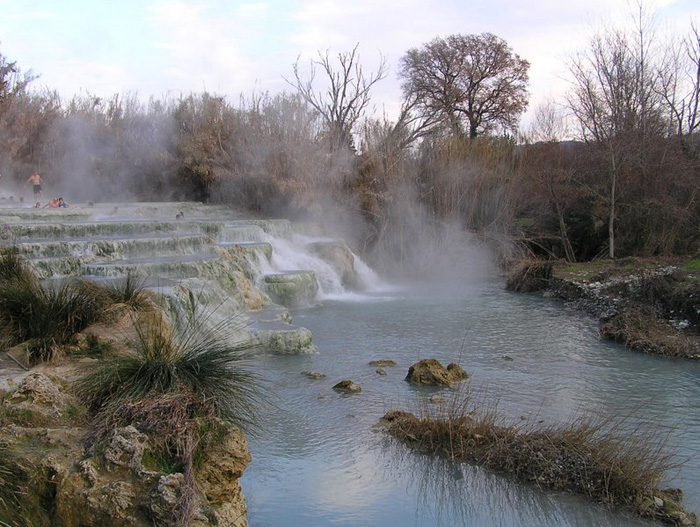 |
||||
|
||||
La Maliosa | Organic Farming in Tuscany La Maliosa is a small farm near Saturnia, setting the world aflame with its incredible organic and bio-dynamic wines and olive oil. La Maliosa embodies Antonella Manuli's concept of natural farming: quality above quantity, pursuit of local traditions and environmental biodiversity. Fattoria La Maliosa was born at the beginning of 2005 on the Monte Cavallo hills close to Terme di Saturnia and halfway between Monte Amiata and the Argentario. Fattoria La Maliosa Loc. Podere Monte Cavallo 58014 MANCIANO (GR) Italia www.fattorialamaliosa.it The farm shop on Via del Ponticino in Manciano. e-mail: info@fattorialamaliosa.it Wines in Tuscany | Organic winegrowing in southern Tuscany |
||||
|
||||
|
||||
 |
||||
Podere Santa Pia, situated in a particularly scenic valley, which overlooks on the hills around Cinigiano, up to Montecristo and Corsica
|
||||
This page incorporates text from the Encyclopædia Britannica, Eleventh Edition. |
||||

